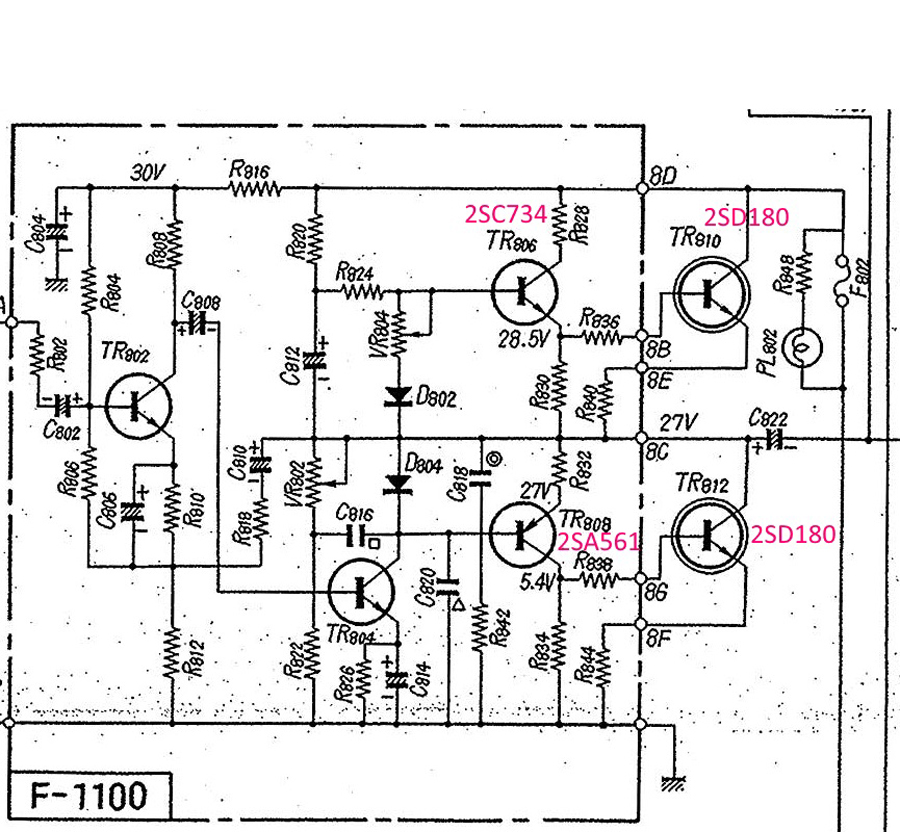Tech Talk
Forum home - Go back to Tech talk
|
Help needed..Sansui 800 transistor replacement.
|
|
|
« Back ·
1 ·
Next »
|
|
|
Return to top of page · Post #: 1 · Written at 1:22:08 PM on 1 August 2018.
|
|
|
|
Location: Sydney, NSW
Member since 29 September 2016 Member #: 1979 Postcount: 52 |
|
Hello everyone. I know this relates to solid state gear, but the Sansui 800 dates to about 1969, so I guess it counts as vintage. My Sansui 800 was faulty in one channel. I have traced the fault. hopefully, to a transistor on the board which immediately precedes the two output transistors. The Base-Emitter junction tests as open. In the schematic below, the faulty one is marked TR808. It's a 2SA561. There are quite a few equivalents listed on the internet, such as the KSA1015, or KSA1015GR. What I don't know is whether I should also replace the transistor TR806, which is a 2SC734. I'm new to this, but it seems the two transistors are part of a push-pull pair, as are the output transistors, and I'm wondering how closely they should be matched. Also, after replacing one or more transistors, are there any other adjustments I need to make? Anyone got some pointers on this situation? I don't want to start desoldering anything until I'm pretty certain what I'm doing. Cheers...thanks in advance.  |
|
|
Return to top of page · Post #: 2 · Written at 1:07:43 PM on 2 August 2018.
|
|
|
|
Location: Belrose, NSW
Member since 31 December 2015 Member #: 1844 Postcount: 2628 |
|
A BC640 will replace a 2SA561. The '640 has higher current and voltage handling capacity as well. |
|
|
Return to top of page · Post #: 3 · Written at 6:55:15 PM on 2 August 2018.
|
|
|
|
Location: Sydney, NSW
Member since 29 September 2016 Member #: 1979 Postcount: 52 |
|
Thanks Ian. As always, I appreciate the help I get on this forum. Cheers. |
|
|
Return to top of page · Post #: 4 · Written at 8:21:33 PM on 5 August 2018.
|
|
|
|
Administrator
Location: Naremburn, NSW
Member since 15 November 2005 Member #: 1 Postcount: 7548 |
|
Diagram uploaded. ‾‾‾‾‾‾‾‾‾‾‾‾‾‾‾‾‾‾‾‾‾‾‾‾‾‾‾‾‾‾‾‾‾‾‾‾‾‾‾‾‾‾‾‾‾‾‾‾‾‾‾‾‾‾‾‾‾‾‾‾‾‾‾‾‾‾‾‾ A valve a day keeps the transistor away... |
|
|
Return to top of page · Post #: 5 · Written at 9:11:11 PM on 5 August 2018.
|
|
|
|
Location: Wangaratta, VIC
Member since 21 February 2009 Member #: 438 Postcount: 5595 |
|
Whilst it predominates in "Solid State" car radios, if there is a considered lack of volume, & you have the facilities to test them? The biggest cause of loss of volume in that sort of stuff, often relates to electrolytic capacitors "drying out". That causes them to lose capacity and is significant in that they used them to couple one stage to the next: Loss of capacity equals loss of coupling. |
|
|
Return to top of page · Post #: 6 · Written at 2:18:24 PM on 14 August 2018.
|
|
|
|
Location: Belrose, NSW
Member since 31 December 2015 Member #: 1844 Postcount: 2628 |
|
If C810 dries out you will get low gain. Low capacitance, the low frequencies will be rolled off. |
|
|
« Back ·
1 ·
Next »
|
|
|
You need to be a member to post comments on this forum.
|
|

Sign In

Vintage Radio and Television is proudly brought to you by an era where things were built with pride and made to last.
DISCLAIMER: Valve radios and televisions contain voltages that can deliver lethal shocks. You should not attempt to work on a valve radio or other electrical appliances unless you know exactly what you are doing and have gained some experience with electronics and working around high voltages. The owner, administrators and staff of Vintage Radio & Television will accept no liability for any damage, injury or loss of life that comes as a result of your use or mis-use of information on this website. Please read our Safety Warning before using this website.
WARNING: Under no circumstances should you ever apply power to a vintage radio, television or other electrical appliance you have acquired without first having it checked and serviced by an experienced person. Also, at no time should any appliance be connected to an electricity supply if the power cord is damaged. If in doubt, do not apply power.
Shintara - Keepin' It Real · VileSilencer - Maintain The Rage
